In this tutorial, we will learn about Different Types of Diodes. These include Small Signal Diodes, Zener Diodes, Light Emitting Diodes, Schottky Diodes, Tunnel Diodes, Avalanche Diodes, etc. This will be a brief note on different types of diodes with their basic functionality and corresponding circuit symbols.
Outline
Toggle- Overview of Diodes
- Different Types of Diodes
- 1. Small Signal Diode
- 2. Large Signal Diode
- 3. Zener Diode
- 4. Light Emitting Diode (LED)
- 5. Constant Current Diodes
- 6. Schottky Diode
- 7. Shockley Diode
- 8. Step Recovery Diodes
- 9. Tunnel Diode
- 10. Varactor Diode
- 11. Laser Diode
- 12. Transient Voltage Suppression Diode
- 13. Gold Doped Diodes
- 14. Super Barrier Diodes
- 15. Peltier Diode
- 16. Crystal Diode
- 17. Avalanche Diode
- 18. Silicon Controlled Rectifier
- 19. Vacuum Diodes
- 20. PIN Diode
- 21. Point Contact Devices
- 22. Gunn Diode
Overview of Diodes
Diodes are two-terminal electronic devices / components that functions as a one-way switch i.e., they allow current to flow only in one direction. These diodes are manufactured using semiconductor materials like Silicon, Germanium and Gallium Arsenide.
The two terminals of the diode are known as Anode and Cathode. Based on the potential difference between these two terminals, the operation of diode can be classified in two ways:
- If anode has higher potential than cathode, then the diode is said to be in Forward Bias and it allows current to flow.
- If cathode has higher potential than anode, then the diode is said to be in Reverse Bias and it doesn’t allow current to flow.
Different types of diodes have different voltage requirements. For Silicon Diodes, the forward voltage is 0.7V and for Germanium diodes, it is 0.3V. Usually, in Silicon Diodes, the dark band on one end of the diode indicates the Cathode terminal and the other terminal is anode.
One of the main application of Diodes is Rectification i.e., to convert AC to DC. Since diodes allow current to flow only in one direction and blocks current flow in the other direction, diodes are used in reverse polarity protector and transient protector applications.
There are many Different Types of diodes and some of them are listed below.
Different Types of Diodes
Let us now briefly see about few common types of diodes.
1. Small Signal Diode
It is a small device with disproportional characteristics whose applications are mainly involved at high frequency and very low current applications such as radios and televisions etc. To protect the diode from contamination it is enveloped with a glass so it is also named as Glass Passivated Diode. One of the popular diodes of this type is the 1N4148.
Appearance wise, signal diodes are very small when compared with power diodes. To indicate the cathode terminal, one edge is marked with black or red color. For applications at high frequencies, the performance of the small signal diode is very effective.
With respect to the other functionalities, the signal diodes usually have a small current carrying capability and power dissipation. Usually, these are in the range of 150mA and 500mW respectively.
The Small Signal Diode can be made of either Silicon or Germanium type semiconductor material, but the characteristics of the diode varies depending up on the doping material.
Small Signal Diodes are used in general purpose diode applications, high speed switching, parametric amplifiers and many other applications. Some important characteristics of Small Signal Diode are:
- Peak Reverse Voltage (VPR) – It is the maximum reverse voltage that can be applied to the diode before it breaks down.
- Reverse Current (IR) – The current (very small value) that flows when it is reverse biased.
- Maximum Forward Voltage at Peak Forward Current (VF at IF)
- Reverse Recovery Time – The time required for reverse current to fall down from forward current to IR.
2. Large Signal Diode
These diodes have large PN junction layer. Thus, they are usually used in rectification i.e., converting AC to DC. The large PN Junction also increases the forward current carrying capacity and reverse blocking voltage of the diode. The large signal diodes are not suitable for high frequency applications.
The main applications of these diodes are in Power Supplies (rectifiers, converter, inverters, battery charging devices, etc.). In these diodes, the value of forward resistance is few Ohms and the value of reverse blocking resistance is in Mega Ohms.
Since it has high current and voltage performance, these can be used in electrical devices which are used to suppress high peak voltages.
3. Zener Diode
It is a passive element which works under the principle of ‘Zener Breakdown’. First produced by Clarence Zener in 1934, it is similar to normal diode in forward bias condition i.e., it allows current to flow.
But in reverse bias condition, the diode conducts only when the applied voltage reaches the breakdown voltage, known as Zener Breakdown. It is designed to prevent the other semiconductor devices from momentary voltage pulses. It acts as voltage regulator.
4. Light Emitting Diode (LED)
These diodes convert the electrical energy in to light energy. First production started in 1968. It undergoes electroluminescence process in which holes and electrons are recombined to produce energy in the form of light in forward bias condition.
In the early days, LEDs are very costly and used only in special application. But over the years, the cost of the LEDs has comedown significantly. This and the fact they are extremely power efficient, makes LEDs as the main source of lighting in homes, offices, streets (for street lighting as well as traffic lights), automobiles, mobile phones.
5. Constant Current Diodes
It is also known as Current-Regulating Diode or Current-Limiting Diode or Diode-Connected Transistor. The function of the diode is to regulate the voltage at a particular current.
It functions as a two terminal current limiter. In this, JFET acts as current limiter to achieve high output impedance. The constant current diode symbol is shown below.
6. Schottky Diode
In this type of diode, the junction is formed by contacting the semiconductor material with metal. Due to this, the forward voltage drop is decreased to a minimum. The semiconductor material is N-type silicon, which acts as an anode and metals such as Chromium, Platinum, Tungsten etc. acts as cathode.
Due to the metal junction, these diodes have high current conducting capability and hence the switching time is reduced. So, Schottky Diode has greater use in switching applications. Mainly because of the metal – semiconductor junction, the voltage drop is low, which in turn increases the diode performance and reduces power loss. So, these are used in high frequency rectifier applications. The symbol of Schottky diode is as shown below.
7. Shockley Diode
It was one of the first semiconductor devices to be invented. Shockley Diode has four layers. It is also called as PNPN diode. It is equal to a thyristor without a gate terminal, which means the gate terminal is disconnected. As there is no trigger input, the only way the diode can conduct is by providing forward voltage.
It stays ON once it turned “ON” and stays OFF once it turned “OFF”. The diode has two operating states conducting and non-conducting. In non-conducting state the diode conducts with less voltage.
The symbol of the Shockley diode is as follows:
Shockley Diode Applications
- Trigger switches for SCR.
- Acts as relaxation oscillator.
8. Step Recovery Diodes
It is also called as snap-off diode or charge-storage diode. These are the special type of diodes which stores the charge from positive pulse and uses in the negative pulse of the sinusoidal signals. The rise time of the current pulse is equal to the snap time. Due to this phenomenon, it has speed recovery pulses.
The applications of these diodes are in higher order multipliers and in pulse shaper circuits. The cut-off frequency of these diodes is very high which are nearly at Giga hertz order.
As multiplier, this diode has the cut-off frequency range of 200 to 300 GHz. In the operations which are performing at 10 GHz range, these diodes play a vital role. The efficiency is high for lower order multipliers. The symbol for this diode is as shown below.
9. Tunnel Diode
It is used as high-speed switch, with switching speed in the order of few nano-seconds. Due to tunneling effect it has very fast operation in microwave frequency region. It is a two-terminal device in which concentration of dopants is too high.
The transient response is being limited by junction capacitance plus stray wiring capacitance. Mostly used in microwave oscillators and amplifiers. It acts as most negative conductance device. Tunnel diodes can be tuned both mechanically and electrically. The symbol of tunnel diode is as shown below.
Tunnel Diode Applications
- Oscillatory circuits.
- Microwave circuits.
- Resistant to nuclear radiation.
10. Varactor Diode
These are also known as Varicap diodes. It acts like the variable capacitor. Operations are performed mainly at reverse bias state only. These diodes are very famous due to its capability of changing the capacitance ranges within the circuit in the presence of constant voltage flow.
They can be able to vary capacitance up to high values. In varactor diode, we can decrease or increase the depletion layer by changing the reverse bias voltage. These diodes have many applications as voltage-controlled oscillator for cell phones, satellite pre-filters etc. The symbol of varactor diode is given below.
Varactor Diode Applications
- Voltage-controlled capacitors
- Voltage-controlled oscillators
- Parametric amplifiers
- Frequency multipliers
- FM transmitters and Phase locked loops in radio, television sets and cellular phone
11. Laser Diode
Similar to LED in which active region is formed by p-n junction. Electrically laser diode is P-I-N diode in which the active region is in intrinsic region. Used in fiber optic communications, barcode readers, laser pointers, CD/DVD/Blu-ray reading and recording, Laser printing.
Laser Diode Types:
- Double Heterostructure Laser: Free electrons and holes available simultaneously in the region.
- Quantum Well Lasers: lasers having more than one quantum well are called multi quantum well lasers.
- Quantum Cascade Lasers: These are heterojunction lasers which enables laser action at relatively long wavelengths.
- Separate Confinement Heterostructure Lasers: To compensate the thin layer problem in quantum lasers we go for separate confinement heterostructure lasers.
- Distributed Bragg Reflector Lasers: It can be edge emitting lasers or VCSELS.
The symbol of the Laser Diode is as shown:
12. Transient Voltage Suppression Diode
In semiconductor devices, transients will occur due to the sudden change in the state voltage. They will damage the device’s output response. To overcome this problem, Voltage Suppression Diodes are used. The operation of voltage suppression diode is similar to Zener diode operation.
The operation of these diodes is normal as p-n junction diodes but at the time of transient voltage its operation changes. In normal condition, the impedance of the diode is high. When any transient voltage occurs in the circuit, the diode enters in to the avalanche breakdown region in which a low impedance is provided.
It is very spontaneously because the avalanche breakdown duration ranges in Pico seconds. Transient voltage suppression diode will clamp the voltage to the fixed levels, mostly its clamping voltage is in minimum range.
These are having applications in the telecommunication fields, medical, microprocessors and signal processing. It responds to over voltages faster than Varistors or gas discharge tubes.
The symbol for Transient voltage suppression diode is as shown below.
The diode is characterized by:
- Leakage current
- Maximum reverse stand-off voltage
- Breakdown voltage
- Clamping voltage
- Parasitic capacitance
- Parasitic inductance
- Amount of energy it can absorb
13. Gold Doped Diodes
In these diodes, Gold is used as a dopant. These diodes are faster than other diodes. In these diodes, the leakage current in reverse bias condition is also less. Even at the higher voltage drop it allows the diode to operate in signal frequencies. In these diodes, Gold helps for the faster recombination of minority carriers.
14. Super Barrier Diodes
It is a rectifier diode having low forward voltage drop as Schottky diode with surge handling capability and low reverse leakage current as P – N junction diode. It was designed for high power, fast switching and low-loss applications. Super barrier rectifiers are the next generation rectifiers with low forward voltage than Schottky diode.
15. Peltier Diode
In this type of diode, it generates heat at the two-material junction of a semiconductor, which flows from one terminal to another terminal. This flow is done in only single direction which is same as the direction of current flow.
This heat is produced due to electric charge produced by the recombination of minority charge carriers. This is mainly used in cooling and heating applications. This type of diodes used as sensor and heat engine for thermo electric cooling.
16. Crystal Diode
This is also known as Cat’s whisker, which is a type of point contact diode. Its operation depends on the pressure of contact between semiconductor crystal and the point.
In this, a metal wire is present, which is pressed against the semiconductor crystal. In this, the semiconductor crystal acts as cathode and metal wire acts as anode. These diodes are obsolete in nature. Mainly used in microwave receivers and detectors.
Crystal Diode Applications
- Crystal diode rectifier
- Crystal diode detector
- Crystal radio receiver
17. Avalanche Diode
This is passive element works under principle of Avalanche Breakdown. It works in reverse bias condition. It results in a large current due to the ionization produced by P – N junction during reverse bias condition.
These diodes are specially designed to undergo breakdown at specific reverse voltage to prevent the damage. The symbol of the avalanche diode is as shown below:
Avalanche Diode Uses
- RF Noise Generation: It acts as source of RF for antenna analyzer bridges and also as white noise generators.
- Used in radio equipment and also in hardware random number generators.
- Microwave Frequency Generation: In this the diode acts as negative resistance device.
- Single Photon Avalanche Detector: These are high gain photon detectors used in light level applications.
18. Silicon Controlled Rectifier
It consists of three terminals they are anode, cathode and a gate. It is nearly equal to the Shockley diode. As its name indicates it is mainly used for the control purpose when small voltages are applied in the circuit. The symbol of the Silicon Controlled Rectifier is as shown below:
Modes of Operation:
- Forward blocking mode (off state): In this J1 and J3 forward biased and J2 is reverse biased. It offers high resistance below breakover voltage and hence it is said to be off state.
- Forward conduction mode (on state): By increasing the voltage at anode and cathode or by applying positive pulse at the gate we can turn ON. To turn off the only way is to decrease the current flowing through it.
- Reverse blocking mode (off state): SCR blocking the reverse voltage is named as asymmetrical SCR. Mostly used in current source inverters.
19. Vacuum Diodes
Vacuum diodes consist of two electrodes which will acts as an anode and the cathode. Cathode is made up of Tungsten, which emits the electrons in the direction of anode. Always electron flow will be from cathode to anode only. So, it acts like a switch.
If the cathode is coated with oxide material, then the electrons emission capability is high. Anode is a bit long in size and in some cases their surface is rough to reduce the temperatures developing in the diode. The diode will conduct only in one case that is when the anode is positive with respect to cathode terminal. The symbol is as shown in figure:
20. PIN Diode
The improved version of the normal P-N junction diode gives the PIN diode. In PIN diode doping is not necessary. The intrinsic material i.e., the material which has no charge carriers, is inserted between the P and N regions, which increase the area of depletion layer.
When we apply forward bias voltage, the holes and electrons will be pushed into the intrinsic layer. At some point due to this high injection level, the electric field will conduct through the intrinsic material also. This field makes the carriers to flow from two regions. The symbol of PIN diode is as shown below:
PIN Diode Applications:
- RF Switches: PIN diode is used for both signal and component selection. For example, PIN diodes acts as range-switch inductors in low phase noise oscillators.
- Attenuators: it is used as bridge and shunt resistance in bridge-T attenuator.
- Photo Detectors: it detects x-ray and gamma ray photons.
21. Point Contact Devices
A gold or tungsten wire is used to act as the point contact to produce a PN junction region by passing a high electric current through it. A small region of PN junction is produced around the edge of the wire which is connected to the metal plate which is as shown in the figure.
In forward direction, its operation is quite similar but in reverse bias condition the wire acts like an insulator. Since this insulator is between the plates, the diode acts as a capacitor. In general, the capacitor blocks the DC currents but the AC currents can flow in the circuit at high frequencies. So, these are used to detect the high frequency signals.
22. Gunn Diode
Gunn diode is fabricated with n-type semiconductor material only. The depletion region of two N-type materials is very thin. When voltage increases in the circuit, the current also increases. After certain level of voltage, the current will exponentially decrease, thus this exhibits the negative differential resistance.
It has two electrodes with Gallium Arsenide and Indium Phosphide. Due to this, it has negative differential resistance. It is also termed as transferred electron device. It produces micro wave RF signals so it is mainly used in Microwave RF devices. It can also use as an amplifier. The symbol of Gunn diode is shown below:

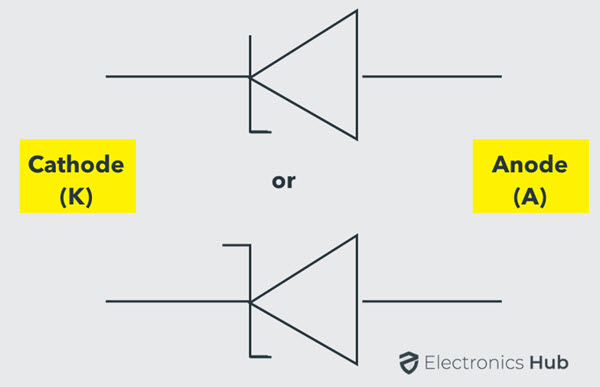

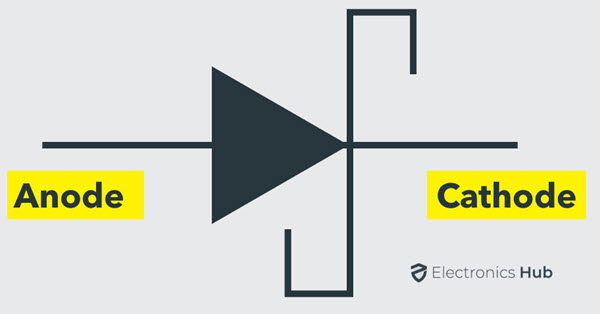

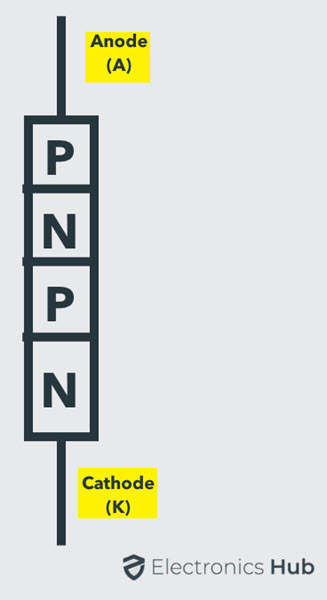
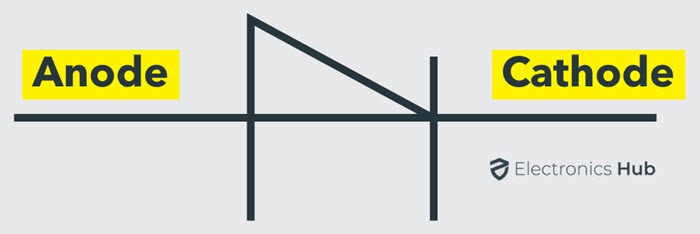
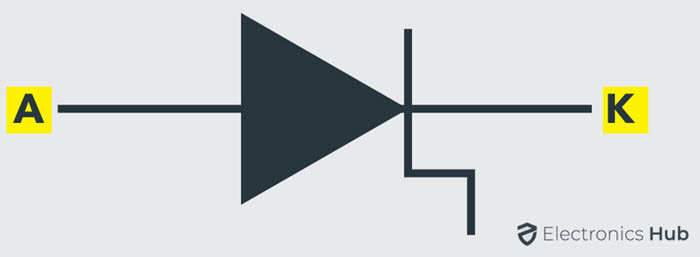



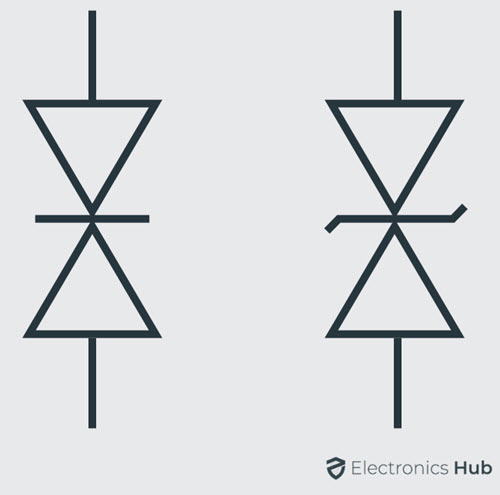
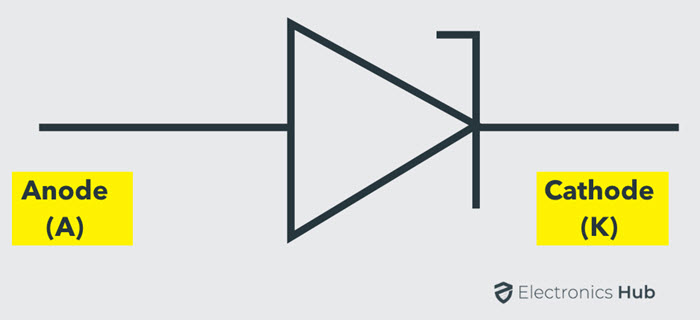
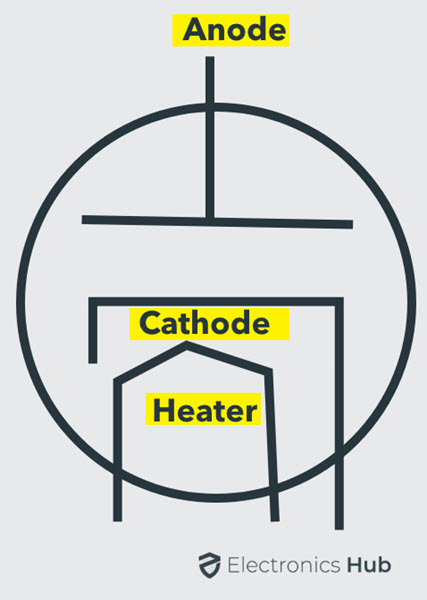




36 Responses
Zener diode nai hai isme
no 3 is zener diode
No U
thank q for best information
Thank u frnd
Thank u for this useful information
Thank you very much. you help several people specially students
Thank u
Thanks a lot more bless
realy , very informable…..
this is a hard core electronics
Thanku so much for such a brief and valuable information…
thank you very much your info
provide a picture with a info if possible
provide a picture with info if possible.it can betterly understand
Very useful information. Thank you very much.
thanks for the information
It is very very important information to learn about different types of semiconductors…….
very important information about the diodes
thanks dia
thank you very much for you explain diodes
Its very helpful
Great work thank you
Very useful for All. Very good tutorial. All tutorials on this website are well explained.
I must confess that this article of Diode has help me much in my academy
Very Use ful for me…Thanks
Very good & useful information all diode types explain properly thanks sir for sharing useful information with us
Thanks alot very useful
Thanku so much for this briefly explaination….
Thanks for bottom of my heart.
For a normal light circuit on a motorcycle. Which diode would I use? If you need more information please ask. And thankyou.
Very useful thank you?
Thanks alot
Very useful thank you.Gbu👍🙏
Thanks alot for the information
Your Web is very helpful. Its is a great sacrifice for students, electronic enthusiasts and other people who have interest to understand basic electronics.
I learned a lot. And will continue to learn more.
Thank you so much.